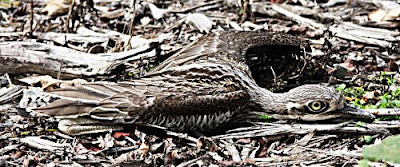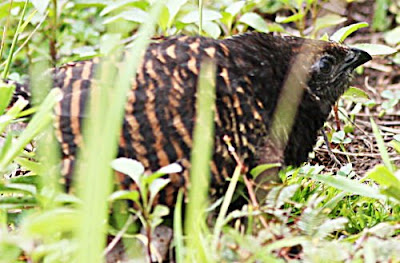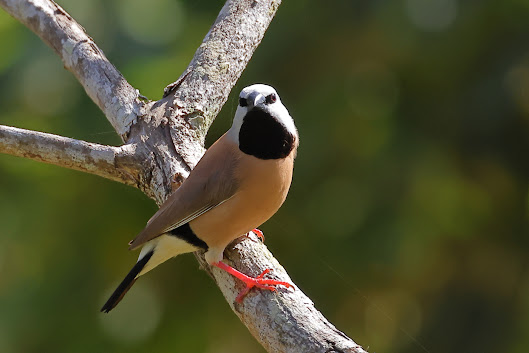
Gloriously 'oily' Metallic Starlings (Aplonis metallica) were busy taking to caterpillars on a Leichhardt tree in Tyto today. The birds appear to have migrated south in lesser numbers this year.
















 Came upon these three Willie Wagtail (Rhipidura leucophrys) hiding in a Leichhardt tree near the Tyto entrance today. In fact, parent birds gave the game away with their chattering and scolding runs at me. Luck continued when the centre bird tried to burst into sound just as I was snapping. Win some, lose some. Birds above lack the symmetry of same three but with righthand bird turning head left (below). And, sadly, didn't manage to keep all three in sharp focus.
Came upon these three Willie Wagtail (Rhipidura leucophrys) hiding in a Leichhardt tree near the Tyto entrance today. In fact, parent birds gave the game away with their chattering and scolding runs at me. Luck continued when the centre bird tried to burst into sound just as I was snapping. Win some, lose some. Birds above lack the symmetry of same three but with righthand bird turning head left (below). And, sadly, didn't manage to keep all three in sharp focus.






 Green, Yellow, Banana. All colourful names. But no more for the male Australasian Figbird (Sphecotheres vielloti), above thinking about swallowing another of the dry, tasteless (to us humans) fruits it loves - and few other birds show great fondness for.
Green, Yellow, Banana. All colourful names. But no more for the male Australasian Figbird (Sphecotheres vielloti), above thinking about swallowing another of the dry, tasteless (to us humans) fruits it loves - and few other birds show great fondness for. Closely related to figbirds (usually on the same page in field guides), the Olive-backed Orioles (Oriolus sagittatus) are less obvious and seldom so brightly plumaged as the above juvenile bird. Much of the contrasting colour on the back will disappear with adult plumage.
Closely related to figbirds (usually on the same page in field guides), the Olive-backed Orioles (Oriolus sagittatus) are less obvious and seldom so brightly plumaged as the above juvenile bird. Much of the contrasting colour on the back will disappear with adult plumage. So much for colour. What about sounds? I've often been struck by what appears in honeyeaters to be more curiosity about strange noises than other birds show. This White-gaped Honeyeater today seemed to react to the Canon's clattering shutter.
So much for colour. What about sounds? I've often been struck by what appears in honeyeaters to be more curiosity about strange noises than other birds show. This White-gaped Honeyeater today seemed to react to the Canon's clattering shutter.
I'd been standing in long grass chasing Tawny Grassbirds when the White-gaped darted in and struck several 'listening' poses as the camera clacked away. Honeyeaters are also among the few birds ever to react at my otherwise ineffectual 'pishing'.
While on the subject of theories, limited searches of possible Little Bittern daytime hideouts have revealed absolutely nothing resembling the apparently shaped space found last month at the base of a small tree springing from Scleria (Razor Grass). Guess it was just a natural artifact.
Finally, the issue of huge fish and small Azure Kingfishers nestlings. First readings suggest the birds simply truck the fish in. If the fish is eaten, fine. If not, it can sit and rot in the darkness. Along with bones, other unwanted morsels, excreta, and anything that may have crawled in.
Can't wait till nestlings have fledged and I get a chance to sniff the delicate odour of Azure domestica! :-(
 No way of knowing where or what nest this Horsfield's Bronze-Cuckoo (Chrysococcyx basalis) sprang from. The young bird was sitting solo on a footbridge handrail. Lack of colour on back and no dark stripe through eye makes ID a tad dodgy. But the plainness of young Horsfield's can be a telling point.
No way of knowing where or what nest this Horsfield's Bronze-Cuckoo (Chrysococcyx basalis) sprang from. The young bird was sitting solo on a footbridge handrail. Lack of colour on back and no dark stripe through eye makes ID a tad dodgy. But the plainness of young Horsfield's can be a telling point. No problems with ID-ing juvenile Brown Honeyeater (Lichmera indistincta). Browns and Yellow Honeyeaters dominate the woodlands. The yellow gape at the base of the bill tells of the bird's immaturity. The typical long honeyeater tongue is a bonus.
No problems with ID-ing juvenile Brown Honeyeater (Lichmera indistincta). Browns and Yellow Honeyeaters dominate the woodlands. The yellow gape at the base of the bill tells of the bird's immaturity. The typical long honeyeater tongue is a bonus.
 This oddly coloured Grey Whistler (Pachycephala simplex) arrived at the rainforest pool today in company with two others. But they didn't seem to be getting along. The small rufous 'ear patch' may perhaps mark the bird as a juvenile. I can't recall seeing anything similar and the guide books haven't helped.
This oddly coloured Grey Whistler (Pachycephala simplex) arrived at the rainforest pool today in company with two others. But they didn't seem to be getting along. The small rufous 'ear patch' may perhaps mark the bird as a juvenile. I can't recall seeing anything similar and the guide books haven't helped.
Also at the rainforest pool today, a brief flurry of action after a long period of nothing larger than mozzies in the air. Silvereyes, White-browed Robins, Shining Flycatchers, Large-billed Gerygones, Little Shrike-Thrushes and Brush Cuckoos showed up noisily. Five minutes later, all quiet.
In back of it all, an Azure Kingfisher sat carrying a huge fish (about twice the size of that in previous post). But the bird would not cross to the nest burrow. So I quit my 'hiding' place. The question is: how do the nestlings cope with a (relatively) gigantic fish? I have no idea, so I'll chase it up.
 Thought I had a sharp shot of this Azure Kingfisher carrying a fish for its nestlings (burrowlings?) yesterday, only to find shaky tripod and high ISO rendered the bird blurred and looking as if I'd gone mad with the saturation slider. On the plus side, the bird went almost straight to the burrow. The minus side? An hour's wait and no more action.
Thought I had a sharp shot of this Azure Kingfisher carrying a fish for its nestlings (burrowlings?) yesterday, only to find shaky tripod and high ISO rendered the bird blurred and looking as if I'd gone mad with the saturation slider. On the plus side, the bird went almost straight to the burrow. The minus side? An hour's wait and no more action. Today, this male Red-backed Fairy Wren carrying a red enticement for females danced here and there on the Scleria. Just wouldn't stay still and unobscured long enough for anything better than this hasty effort - and many others even less successful.
Today, this male Red-backed Fairy Wren carrying a red enticement for females danced here and there on the Scleria. Just wouldn't stay still and unobscured long enough for anything better than this hasty effort - and many others even less successful. Good pose from a distant White-browed Robin in the shade. This typical robin angled hold on a vertical trunk is seldom seen in Tyto, possibly because White-broweds behave and forage more like flycatchers or fantails most of the time. This bird was taking a short break from nest-sitting.
Good pose from a distant White-browed Robin in the shade. This typical robin angled hold on a vertical trunk is seldom seen in Tyto, possibly because White-broweds behave and forage more like flycatchers or fantails most of the time. This bird was taking a short break from nest-sitting. Finally, this Tawny Grassbird the other day led me a circular dance through long grass and under low trees. Round and round we went, the bird singing heartily and me muttering mightily. It might look a draw, but I think the singer more or less won the day.
Finally, this Tawny Grassbird the other day led me a circular dance through long grass and under low trees. Round and round we went, the bird singing heartily and me muttering mightily. It might look a draw, but I think the singer more or less won the day.
 So, the mothing didn't take off. But the evening wasn't a dead loss, except for one victim of events. One other player in my little night out did throw a hissy fit. But that's what Rhinoceros Beetles do when upset: all hiss and wind!
So, the mothing didn't take off. But the evening wasn't a dead loss, except for one victim of events. One other player in my little night out did throw a hissy fit. But that's what Rhinoceros Beetles do when upset: all hiss and wind!
And the night's victim? Don't look down if you're squeamish.
These two geckos began their duel to the death locked in a curious Yin and Yang pattern, an almost circle of sinous curves, sinister intent and subtle feints.
I missed the critical strike after racing off for a camera. Came back to find the geckos shifted from tactical circle to death round.
 As the Eastern mystics say: a good big guy will always beat a good little guy.
As the Eastern mystics say: a good big guy will always beat a good little guy.
 Another morning at Taylors Beach today looking for birds such as Striated Herons (Butorides striatus) silly enough to keep standing around as the tide retreated and I advanced across the wet sand.
Another morning at Taylors Beach today looking for birds such as Striated Herons (Butorides striatus) silly enough to keep standing around as the tide retreated and I advanced across the wet sand.

 Azure Kingfisher (Alcedo azurea) sits and waits at the oft-mentioned rainforest pool today for the right moment to zoom across and into the nest tunnel.
Azure Kingfisher (Alcedo azurea) sits and waits at the oft-mentioned rainforest pool today for the right moment to zoom across and into the nest tunnel.  After that terrible picture of bird and fish, here's something a little better. Olive-backed Oriole sits watchfully above a low-slung nest in Tyto's first shady grove of trees. The nest is in plain view just a few metres from the main track.
After that terrible picture of bird and fish, here's something a little better. Olive-backed Oriole sits watchfully above a low-slung nest in Tyto's first shady grove of trees. The nest is in plain view just a few metres from the main track. White-browed Crake (Porzana cinerea) chick took an unusual turn at Tyto today. It took to the water instead of getting under vegetation's cover.
White-browed Crake (Porzana cinerea) chick took an unusual turn at Tyto today. It took to the water instead of getting under vegetation's cover. Then it changed its mind and took to the water. Another change of mind - possibly in response to calls from the vegetation - and it finally did the 'natural' thing and got out of sight. Black isn't such a protective colour in blazing sunlight!
Then it changed its mind and took to the water. Another change of mind - possibly in response to calls from the vegetation - and it finally did the 'natural' thing and got out of sight. Black isn't such a protective colour in blazing sunlight! Here's the pair doing their usual trick of hiding out right in front of the birdo. But the reeds don't do a great job disguising them. They prefer more mixed cover, and quickly headed off to find some. I did manage one so-so flight picture.
Here's the pair doing their usual trick of hiding out right in front of the birdo. But the reeds don't do a great job disguising them. They prefer more mixed cover, and quickly headed off to find some. I did manage one so-so flight picture.
 Almost bumped into this dingo (Canis lupus dingo) on a track near the rainforest pools today. She and another larger dingo were standing rock-still and staring intently into some guinea grass and lantana.
Almost bumped into this dingo (Canis lupus dingo) on a track near the rainforest pools today. She and another larger dingo were standing rock-still and staring intently into some guinea grass and lantana. Juvenile White-browed Robin (Poecilodryas superciliosa) on a branch near the lookout knoll at Tyto, no more than 50 metres from a nest site that I watched off and on early in October.
Juvenile White-browed Robin (Poecilodryas superciliosa) on a branch near the lookout knoll at Tyto, no more than 50 metres from a nest site that I watched off and on early in October. But the Brown-backed Honeyeaters (Ramsayornis modestus) have returned to the hide and are rebuilding the nest they started and abandoned - and which the Rufous-throated Honeyeaters looted. Brown-backeds' nesting habits are certainly erratic.
But the Brown-backed Honeyeaters (Ramsayornis modestus) have returned to the hide and are rebuilding the nest they started and abandoned - and which the Rufous-throated Honeyeaters looted. Brown-backeds' nesting habits are certainly erratic.
 Bush Stone Curlew spreads out after being caught unawares over the weekend. It wasn't the only one caught out lately.
Bush Stone Curlew spreads out after being caught unawares over the weekend. It wasn't the only one caught out lately.  Not moving at all at the weekend, was this young Pheasant Coucal. It stayed motionless after I first spied it at the edge of some much longer guinea grass. In fact, it remained so still I started to consider the shape might be vegetable rather than animal.
Not moving at all at the weekend, was this young Pheasant Coucal. It stayed motionless after I first spied it at the edge of some much longer guinea grass. In fact, it remained so still I started to consider the shape might be vegetable rather than animal.Hollow logs for at risk birdies? Nature's nest boxes if you please Oh, such a clever wheeze So gather in twos and threes? Hundreds you w...
